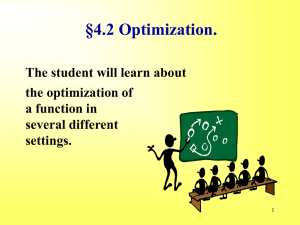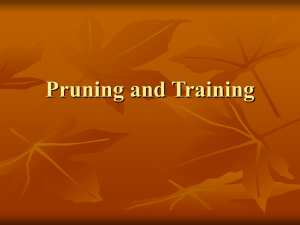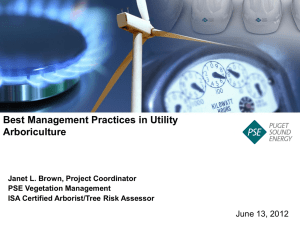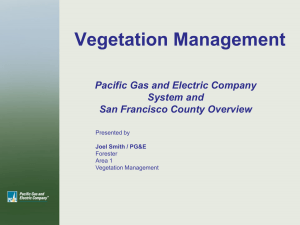Avocado Canopy Management
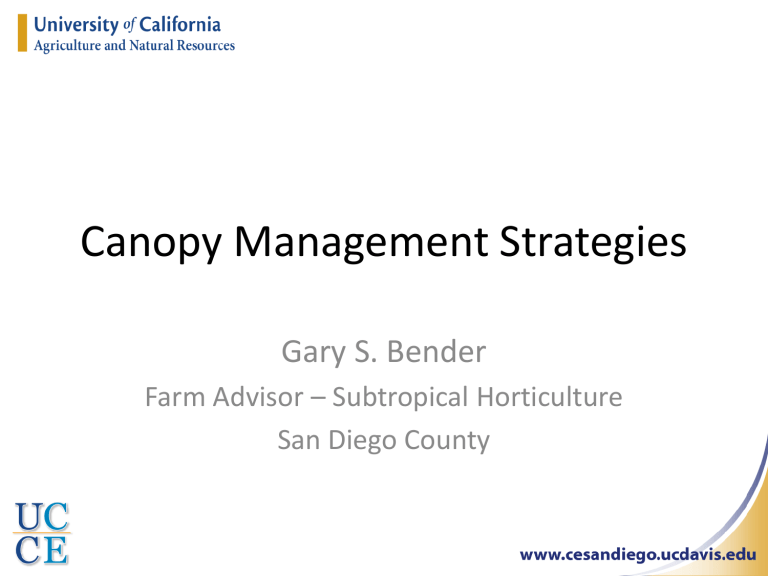
Canopy Management Strategies
Gary S. Bender
Farm Advisor – Subtropical Horticulture
San Diego County
The Farm Advisor in California
• Applied Research Program
• Education of Growers
• I have a background in plant pathology
• But I have to work on diseases, entomology, soils, irrigation, rootstocks, varieties, pruning etc
• Also be an expert on citrus, blueberries, litchi, longan, guava, cherimoya, pitaya, deciduous fruit etc.
• I have to be an expert on everything!
The Problem:
• Our avocado trees are too tall!
• We grow on mountains
• Picking is very slow because pickers are working from ladders that are 30 ft (9 m) high, using 10 ft picking poles to reach the fruit
• Growers don’t know how to prune
$1 400
$1 200
$1 000
$800
$600
$400
$200
$0
Valley Center - Water Rate Schedule
Domestic Agricultural
We have to worry about Costs.
What are Operating Costs?
• These are costs to actually farm the crop
• Herbicide, bee hive rental, road repair, harvesting, packing,
CAC assessment, spraying for thrips, PCA, fertilizer, water, labor
• Water is the big one
• At four ac ft/acre, at
$1300 per acre ft, water cost is $5200 per acre
• For ten acres this will be
$52,000!
As a Result –
Avocado Acreage is Declining
• High water prices makes it impossible for growers to make money at the county average yield (5,000 lbs/acre), unless they get $2/lb
• We need to increase yield/acre
• How do we do that?
Can we improve yield by pruning large trees?
• To answer this question we designed a pruning trial in
1998 that would compare 8 different styles of canopy management.
• Our goal was to develop methods that could improve yield, and trees that could be picked from the ground
Original Pruning Trial
(implemented in 1998)
• 3 groves in Ventura
County
• 3 groves in San Diego
County
• Each grove would have all 7 pruning methods and a non-pruned control block
• Each pruning method would have at least 16 trees in a block
• 2 groves suffered severe frost damage, and 2 growers backed out of the trial
• Left with 1 grove in
Ventura and 1 in San
Diego
• Data lost from the
Ventura grove in 2003
At the completion of the trial
• The trial ended in 2005
• We have six years of individual tree harvest data (at least sixteen trees from each pruning method) from only one ranch
• Due to lack of replication, we can’t statistically analyze the data and publish in a journal
• However, we have some interesting data!
• (and we made some mistakes)
Styles of Canopy Management
• Non-pruned control
• Cal Poly low stump (1m or 3 ft), vase shape
• Stump - Single Leader
• Stumped, no follow-up
• Thinned
• Australian 2-cut method
• Cal Poly high stump (
2.5 m or 8 ft), vase shape
• Israeli method
Stumping (no follow-up pruning)
• Normally done in
California
• Trees are cut back to stumps about 3 ft high
(1 m), no pruning
• Stump is painted with white water-based paint to prevent sunburn
Stumping - Cal Poly Style
• Suggested by a professor at California
Polytechnic College
• Trees are kept at 13 ft (4 m) in height
• Center is opened like a vase shape
• Sides of canopy lightly pruned each year
Stumping - Single Leader
• Trees are kept at 13’ (4 m) in height
• A strong branch growing upright in the center is kept as the leader
• Others are nipped back soon after fruit set each year
Australian 2 Cut
• Suggested by a grower who returned from Australia
• Each year the highest branch is cut back to 20’ (6 m) in height
• And the most vigorous branch growing into the adjacent tree is cut back
• Only two cuts are made
• This slowly brings the tree down and back into its proper place
• This keeps the tree in production while it is being rejuvented
• But, cutting the center branch back is dangerous!
Israeli Method
• Suggested by two Israeli farm advisors
• Tree is divided into five main branches
• Start this year cutting back the branch aimed toward the afternoon sun.
• Each year cut one more branch
• This keeps the tree in good production and by the fifth year the tree is rejuvenated
• All cutting is done from the ground
• Simple and easy for grove workers
Thinning
Suggested by Bob Platt, former UC Extension Specialist
Every other tree is removed
Old research from the 1970’s showed that removing ½ of the
Fuerte trees could increase production per acre
Thinning
Accumulated Yield per Acre, 1999-2004
140,000
120,000
100,000
80,000
lbs/acre
60,000
40,000
20,000
0
C al
C on tro l ly,
lo w
st ump
Si ng
Po le
le ad er ed
, n o fo llo w
-u p
St ump
Th in ne d
C al
Po t
2-cu ly,
h ig h st ump
Isra el i me th od
Treatment
2004
2003
2002
2001
2000
1999
Cost Analysis (per acre)
Treatment
Non-pruned control
Cal Poly low stump
Single leader
Stumped, no follow up
Thinning
2-cut
Cal Poly high stump
Israeli method
Gross return
1998-2004
123,496
(minus pruning costs and extra management costs)
(0)
(minus picking costs) 1
(19,759)
Net return per acre
103,737
11,918
29,430
44,718
85,509
77,767
10,074
83,515
(2,575.13)
(2,697.75)
(1,437.44)
(1,058.80)
(2,111.90)
(2,656.93)
(1,430.70
)
(953)
(2,354)
(3,577)
(8,550)
(12,442)
(806)
(8,351)
8,390
24,379
41,844
75,901
63,214
6,612
73,734
1 Picking costs assume costs measured in 2002 as the costs for life of the research project. Costs are as follows: control ($0.16/lb), Cal Poly low stump ($0.08/lb), Single leader
What Did We Learn?
• With the Stumped Trees:
• The 80% rule proposed by Pete Stassen in South
Africa seems to be about right. Therefore a tree on a
20’ (6 m) x 20’ (6 m) spacing should not be higher than 16’ (4.8 m) in order to maintain production in the lower canopy. To maintain a tree at 16’ (4.8), the tree should be pruned at 14’ (4.5 m)
• Keeping a tree at this height takes about 10 minutes per tree, twice a year .
What Did We Learn?
• Pruning after the summer flush reduces yield, all pruning should be done before August to preserve the summer flush for flower production
• ‘Stumping with no follow up pruning ’ seems to stimulate production.
• Picking costs are very low in stumped, low-height trees, and very high in non-pruned, high trees
• ‘Stumping with no follow-up pruning’ becomes very crowded in the fifth-sixth year. Leaves are falling off lower branches in the shade
Other Considerations
• Labor supply and skill in harvesting is a major issue in the avocado industry and will be more so in the future
– If this assumption is true, then we need to develop methods to prune trees and maintain trees at a low height, but with minimal removal of fruiting wood.
A Big Mistake:
• We didn’t pay attention of On-Cycle trees and
Off-Cycle trees
The Modern Avocado Grove
• Trees maintained low with pruning
• Pollinizers planted so each Hass ‘sees’ a pollinizer tree
• Plenty of bees (3-4 hives per acre)
• Bloom sprays and mulching
• No water stress, leaching salts periodically
• Active scouting and spot treatment for insects and diseases
• But, How do we prune??
Table 1.
Hass avocado yield data supplied by the grower for a high density planting in Temecula. 384 trees /acre = 0.88 acre. Yield data adjusted to pounds/acre.
Two High Density Groves in San Diego (lbs/acre)
2004 planted
2005
2006
2007
2008
2009
2010
2011
0
0
2,727 (est.)
3,636 (est.)
2,727 (est.)
4,545
32,727
4,318
2006 planted
2007
2008
2009
2010
2011
0
0
0
5,080
7,656
24,195
County Average Yield: 6,000 lbs/acre
A New Research Project
• High Density Trial 10’ x 10’ (3m x 3m) spacing
• Each Hass tree facing a Zutano for pollination
• 3-4 hives of bees per acre
• Irrigation and fertilization carefully managed
• Hass and Lamb Hass on Dusa rootstocks
• Goal: Maximize yield per acre
H
Z
H
H
H
Z
H
H
Z
H
H
H
H
H
H
H
H
H
H
H
H
H
H
H
H
H
H
H
H
H
H
H
H
H
H
H
H
H
H
H
H
H
H
H
H
H
Z
H
H
H
Z
H
H
Z
H
H
H
H
H
H
H
H
H
H
H
H
H
H
H
H
H
H
H
Z
H
H
H
Z
H
H
Z bees bees bees bees
This will be a Pruning Trial on
High Density Hass and Lamb Hass
1. All sides pruned and topped each year (1/2 of the trees)
2. Southwest side pruned in first year, Northeast side pruned in second year, Trees topped in third year
• Three year rotation
• There will always be fruiting wood on the tree
• This is easy for grove workers
How will we prune?
• We will follow the suggestion by Gardiazabal and Mena (CAS Yearbook 2011)
1. Prune in first year to establish central leader
2. Prune vigorous upright shoots in the subsequent years that compete with the central leader
3. Prune weak branches to create small holes in the canopy for light penetration
4. In later years prune vigorous side branches to maintain the central leader shape
5. Perhaps use growth regulator NAA to reduce regrowth
How tall should the trees be?
• 80% of 10’ (3m) should be about 8’ (2.4m)
As for On-Cycle trees vs. Off-Cycle trees
• Recently Claudio Hernandez and Felipe Brunet gave an excellent talk in California on pruning high density trees
• On-cycle have: heavy flowering, high yield the following year, small fruit size, limited development of spring shoots, sun damage, poor growth in summer, low flowering in the next year
• These can be pruned in the early spring to reduce some of the flowers
• Off-cycle trees have poor flowering, low yield
(for the following year), large fruit, increased spring shoots, high vigor of summer shoots, increased intensity of flowering in the following year
• It is good to summer prune these tree to reduce the intensity of flowering in the following year
High density: grower must be convinced
1. Pruning should be done every year
2. Grower must accept loss of some fruit to contribute good fruit quality
3. Prune early in On –cycle year (early spring)
4. Prune late in Off-cycle year (summer prune)
5. Height control
6. Do not reduce canopy more than 30%
Hernandez and Brunet
Questions to be answered
• Can you afford the cost of the trees initially?
• What is the cost of the labor for pruning?
• Is the labor available?
If you don’t keep up on the pruning, your trees will look like this!
Gracias
Gary Bender gsbender@ucanr.edu


